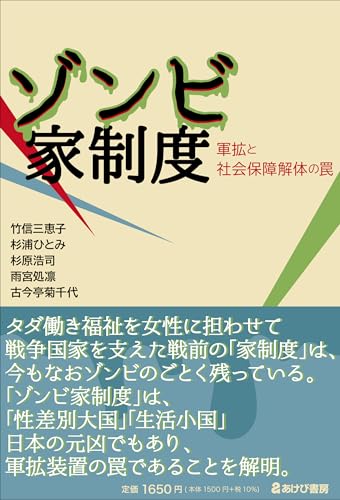
What is the “Teru-Teru Reading Circle”?
In 2012, after the late Teruko Inoue, a leading expert in women's studies (“the study of women by women for women”), retired from Wako University, she started the “Thursday Study Group”. In AY 2014 the name was changed to the “GF Reading Group”, and reports on their activities were posted on the Women's Studies Course Corner of the WAN website every half year. After the death of Professor Inoue in 2021, the group continued its activities online as the “Teru-Teru Reading Circle”. The members are women in their 30s to 70s from a variety of backgrounds. We are currently looking for new members. Please contact us at: teruterurc@gmail.com
Book Introduction
This was the first time I had read a book with a “phantom table of contents”. In this book, the history of feminism in Japan over the 150 years since the Meiji Restoration is organized into four periods. The structure of the book is such that, with the time periods on the horizontal axis and the areas of feminist concern on the vertical axis, it provides a comprehensive overview of how various issues were dealt with in each era and how feminists fought for their rights. However, due to the sudden death of the author, the description of the second wave of feminism (from 1970) onwards is “unfinished”.
The general history of the period from 1868 to 1970, which is included in Part 1, features the names of many women. As can be seen from the “Index of Names” at the end of the book, it is a painful reminder of how women have been excluded and rendered invisible in the history of feminism to date. The various debates introduced in detail here, such as the debates under the first wave of feminism (the chastity debate, the maternal protection debate, the abortion debate, and the birth control debate), and the post-war housewife debate, are not at all dated for those of us living in the present day.
Part 2 begins with a fragment that was put together on a sickbed. The author, who wrote this book as “work that only I can do” and pointed out the “imbalance” and lack of balance in women's history research, gives a masterful account of her perspective as someone who had seen women's liberation “from the inside”. By reading the colloquial-style memos, the discussions as a researcher, and the symposium records, you can understand the general history of Part 1 and the various contemporary issues in a connected way.
After the reading group
In the year after Professor Inoue's sudden death (2022), we spent over half a year (21 sessions in total) carefully reading the book, each of us preparing a summary of the book as if to mull over the professor's thoughts. I think that the time we spent sharing the loss, which was too great to bear alone, with the other members of the reading group and taking in the professor's words also functioned as grief care. In this book, Professor Inoue writes about the creation of the reading group, saying that she aimed to create a place where “each participant, regardless of their knowledge or academic background on gender, can speak freely and openly without worrying about what anyone else thinks, and can listen to opinions and thoughts that differ from their own” [p311]. Practicing the “level playing field” relationship that is valued in the feminist movement is very difficult, with no right answers or clear goals. That's why I want to continue trying and making mistakes as I create a reading group that carries on the ideas of the late Professor Inoue.
◆Bibliography Data
Title: Japanese Feminism: People and Ideas over 150 Years
Author: Teruko Inoue
Number of pages: 342 pages
Date of publication: 2021/12/8
Publisher: Yuhikaku
Price: 2420 yen (including tax)
Original article in Japanese by Airi Watanabe

 慰安婦
慰安婦 貧困・福祉
貧困・福祉 DV・性暴力・ハラスメント
DV・性暴力・ハラスメント 非婚・結婚・離婚
非婚・結婚・離婚 セクシュアリティ
セクシュアリティ くらし・生活
くらし・生活 身体・健康
身体・健康 リプロ・ヘルス
リプロ・ヘルス 脱原発
脱原発 女性政策
女性政策 憲法・平和
憲法・平和 高齢社会
高齢社会 子育て・教育
子育て・教育 性表現
性表現 LGBT
LGBT 最終講義
最終講義 博士論文
博士論文 研究助成・公募
研究助成・公募 アート情報
アート情報 女性運動・グループ
女性運動・グループ フェミニストカウンセリング
フェミニストカウンセリング 弁護士
弁護士 女性センター
女性センター セレクトニュース
セレクトニュース マスコミが騒がないニュース
マスコミが騒がないニュース 女の本屋
女の本屋 ブックトーク
ブックトーク シネマラウンジ
シネマラウンジ ミニコミ図書館
ミニコミ図書館 エッセイ
エッセイ WAN基金
WAN基金 お助け情報
お助け情報 WANマーケット
WANマーケット 女と政治をつなぐ
女と政治をつなぐ Worldwide WAN
Worldwide WAN わいわいWAN
わいわいWAN 女性学講座
女性学講座 上野研究室
上野研究室 原発ゼロの道
原発ゼロの道 動画
動画



![[広告]広告募集中](https://wan.or.jp/assets/front/img/side_ads-call.png)












